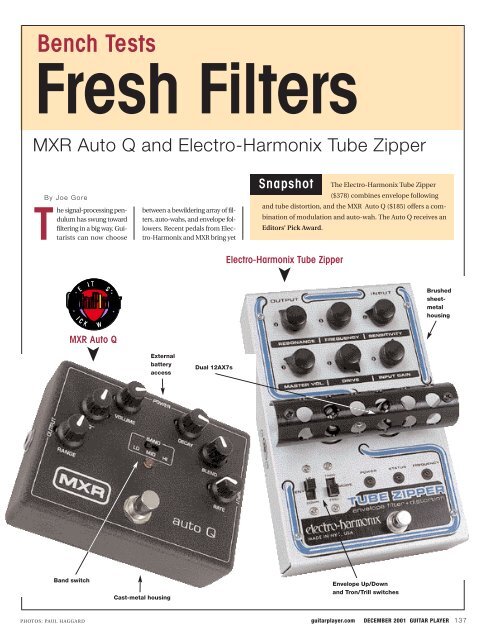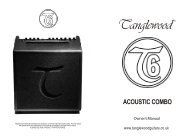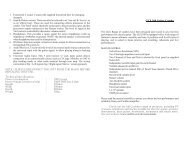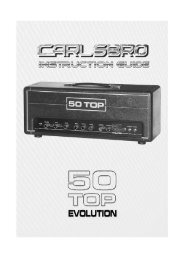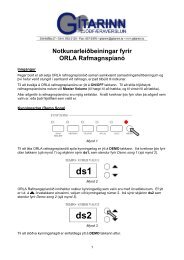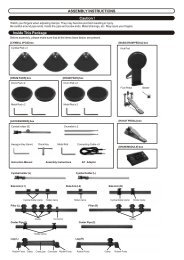MXR Auto Q
MXR Auto Q
MXR Auto Q
You also want an ePaper? Increase the reach of your titles
YUMPU automatically turns print PDFs into web optimized ePapers that Google loves.
Bench Tests<br />
Fresh Filters<br />
<strong>MXR</strong> <strong>Auto</strong> Q and Electro-Harmonix Tube Zipper<br />
By Joe Gore<br />
The signal-processing pendulum<br />
has swung toward<br />
filtering in a big way. Guitarists<br />
can now choose<br />
between a bewildering array of filters,<br />
auto-wahs, and envelope followers.<br />
Recent pedals from Electro-Harmonix<br />
and <strong>MXR</strong> bring yet<br />
Snapshot<br />
The Electro-Harmonix Tube Zipper<br />
($378) combines envelope following<br />
and tube distortion, and the <strong>MXR</strong> <strong>Auto</strong> Q ($185) offers a combination<br />
of modulation and auto-wah. The <strong>Auto</strong> Q receives an<br />
Editors’ Pick Award.<br />
Electro-Harmonix Tube Zipper<br />
➤<br />
Brushed<br />
sheetmetal<br />
housing<br />
<strong>MXR</strong> <strong>Auto</strong> Q<br />
➤<br />
External<br />
battery<br />
access<br />
Dual 12AX7s<br />
Band switch<br />
Cast-metal housing<br />
Envelope Up/Down<br />
and Tron/Trill switches<br />
PHOTOS: PAUL HAGGARD<br />
guitarplayer.com DECEMBER 2001 GUITAR PLAYER 137
Bench Tests<br />
Contact Info<br />
Fresh Filters<br />
more new tricks to the auto-wah<br />
arena. Each box has its own idea<br />
of what will inspire guitarists, and<br />
their sonic characters couldn’t be<br />
more different.<br />
Electro-Harmonix<br />
Tube Zipper<br />
As proven by hordes of aggrorock<br />
guitarists, filtering and distortion<br />
go together like assault<br />
and battery. The Tube Zipper<br />
($378) combines both effects for<br />
Electro-Harmonix, 20 Cooper Sq., 4th fl., New York, NY 10003;<br />
(212) 529-0466; ehx.com.<br />
<strong>MXR</strong>, dist. by Dunlop Manufacturing, Box 846, Benicia, CA<br />
94510; (707) 745-2722; jimdunlop.com.<br />
one-stop audio carnage. The Zipper’s<br />
distortion is the real tube<br />
deal—two 12AX7s protrude from<br />
the light aluminum housing, protected<br />
by a sturdy metal bonnet.<br />
The pedal requires an AC adapter<br />
for operation, but the included 12-<br />
volt adapter connects via an unconventional<br />
jack—a bummer<br />
should you need to replace a dead<br />
power supply on short notice.<br />
The Zipper’s six knobs and two<br />
switches promise lots of action.<br />
There are separate Gain and Drive<br />
controls, as well as a master volume<br />
(a great feature, given that resonant<br />
filter sweeps can cause huge<br />
volume changes). Furthermore,<br />
you can choose between upward<br />
sweeps (the “normal” autowah/envelope<br />
follower sound, in<br />
which the filter opens to its brightest<br />
sound, and then gets darker)<br />
and downward ones (the lesscommon<br />
alternative, in which<br />
sounds immediately suck down<br />
into a dark mass, and then bloom<br />
brighter). Also onboard: a Tron/Trill<br />
switch that toggles between<br />
straight envelope following (where<br />
Continued on page 149<br />
The Ratings Game<br />
Tone Workmanship Vibe Value<br />
<strong>MXR</strong> <strong>Auto</strong> Q 3 4 3 4<br />
Electro-Harmonix Tube Zipper 5 4 4 5<br />
The Rate-O-Meter: Dismal = Excellent =<br />
guitarplayer.com DECEMBER 2001 GUITAR PLAYER 139
GUITAR BAZAAR<br />
Round & Round<br />
Continued from page 134<br />
system or recording console (there’s no need to<br />
slap an SM57 on the front grille).<br />
Round Sound<br />
With the rotating effect off, the Sidewinder<br />
produces a warm, meaty tone. The single 12AX7<br />
does an admirable job of delivering big, clean<br />
tones at low settings, and nice, overdriven textures<br />
when you turn up the gain knob to five or six.<br />
However, extreme settings on either the gain or<br />
volume controls bring out a harsh, splattery quality.<br />
I obtained the best results with the gain and<br />
volume controls set no higher than 7.<br />
The Sidewinder also sports an Accutronics<br />
reverb with an accompanying tone control. The<br />
reverb sounds great, and the tone control makes<br />
it possible to change the character of the amp<br />
by making only the reverberated signal brighter<br />
or darker. It’s a subtle, almost subliminal effect,<br />
but it’s very cool.<br />
Engage the rotating chute’s slow speed, and<br />
the Sidewinder instantly comes to life with a lush,<br />
3-D tone. Imagine plugging into a top-quality chorus<br />
pedal, and then running it to three or four<br />
amps—that’s how dramatically this effect envelops<br />
you. At the slowest speed, the effect is kind of like<br />
organic phasing. Medium speeds bring out more<br />
of a chorused sound, and fast speeds excel at spoton<br />
B-3 imitations and instant psychedelia—bubbling,<br />
gurgling textures ricochet around the room.<br />
The effect is intense, but it never sounds “gimmicky.”<br />
Even the fastest speeds produce musical<br />
timbres. When you shut the rotor off, an auto-stop<br />
function plants the chute at the optimal point to<br />
disperse your tone out front.<br />
Motion Detector<br />
On a gig, I tested the Sidewinder two ways.<br />
First, as a stand-alone combo with a Tele and<br />
a Tube Screamer in the front end. In this configuration,<br />
the Sidewinder’s rotary effect was undeniably<br />
hip, but the volume output felt slightly<br />
anemic—especially considering the amp’s 100-<br />
watt rating. Fortunately, the built-in microphone<br />
and XLR output made it easy to beef up my tone<br />
through the house sound system.<br />
Then I ran the recording output of a Hughes<br />
& Kettner zenTera into the Sidewinder’s input to<br />
send a variety of amp sounds—plus effects—to<br />
the Sidewinder and apply the rotary effect. Although<br />
the setup may seem needlessly complex,<br />
it proved to be very flexible. Even when the chute<br />
wasn’t spinning, adding the Sidewinder to my<br />
backline spread out the sound nicely. But when<br />
the rotor was engaged, the Sidewinder acted like<br />
a parallel loop for the Leslie sound—my original<br />
tone was still there, but with a dreamy, swirling<br />
ambience. The result was so cool that I hardly<br />
ever shut the rotor completely off—I’d simply go<br />
with the slow speed if I wanted a more subtle effect.<br />
The Sidewinder sounded great on an outdoor<br />
gig, but its effect was even more amazing<br />
on a club date, where there were walls and a mirror<br />
for the sound to bounce off of. In addition,<br />
there was another guitarist on these gigs, and the<br />
Sidewinder made it easy to avoid stepping on his<br />
toes. I simply turned the rotor to the fast speed<br />
and comped with faux-organ stabs.<br />
Spin Out<br />
The Sidewinder is a good-sounding, lightweight<br />
amp that proves the old adage, “There’s<br />
nothing like the real thing.” As cool as many of<br />
the rotary-speaker simulators on the market are,<br />
they can’t duplicate the Sidewinder’s deliciously<br />
complex, swirling tone.<br />
Using the Sidewinder as a stand-alone combo,<br />
however, will require a few adjustments to<br />
compensate for its lack of channel switching<br />
(you can plug an overdrive pedal into the amp’s<br />
front end) and less-than-mighty output (you can<br />
boost the signal by routing the amp’s internal<br />
mic to a P.A. system). But as a powered extension<br />
cab, the Sidewinder is totally cool, and it’s not<br />
much more expensive than many high-quality<br />
unpowered cabs—and those don’t even spin! g<br />
Contact Info<br />
Motion Sound, 4426 South 450 W.,<br />
Ste. G, Salt Lake City, UT 84123;<br />
(801) 265-0917; motion-sound.com.<br />
Smooth Operator<br />
Continued from page 131<br />
bridge makes it easy to manipulate the tone and<br />
volume controls while playing.<br />
The neck is equally comfy, with an ultraflat<br />
fretboard (Godin says it actually tapers<br />
inward toward its center) and expertly installed,<br />
buttery-smooth frets. The feel is fast<br />
and light, and the wide cutaway makes it easy<br />
to maneuver in the top register. This stressfree<br />
feel makes the LG a superb choice for guitarists<br />
with small or weak hands, as well as<br />
those contending with playing pain.<br />
Zing Thing<br />
The Godin LG is a bang-for-buck winner<br />
that offers remarkable components, tones, and<br />
workmanship for its price range. Its sounds emphasize<br />
delicacy and detail over blood and<br />
thunder, but it would make a great foil to a more<br />
carnivorous ax in a two-guitar context. The LG<br />
also merits special praise for its silky playability.<br />
This guitar is, to plagiarize a memorable British<br />
beer commercial, “Smoother than an ocelot<br />
cheating at baccarat.” g<br />
142 GUITAR PLAYER DECEMBER 2001 guitarplayer.com


